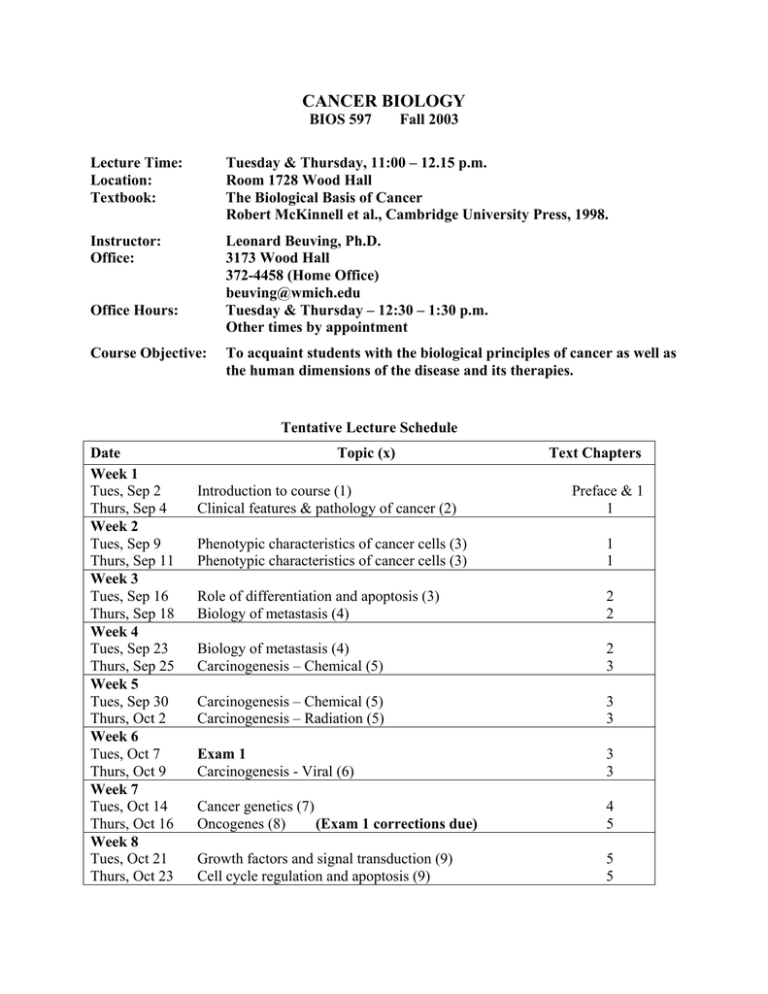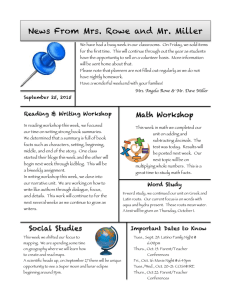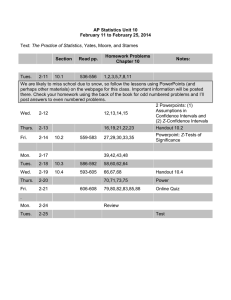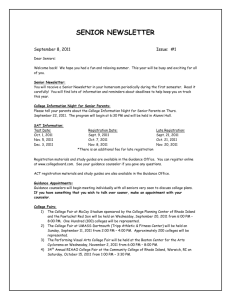CANCER BIOLOGY
advertisement

CANCER BIOLOGY BIOS 597 Fall 2003 Lecture Time: Location: Textbook: Tuesday & Thursday, 11:00 – 12.15 p.m. Room 1728 Wood Hall The Biological Basis of Cancer Robert McKinnell et al., Cambridge University Press, 1998. Instructor: Office: Leonard Beuving, Ph.D. 3173 Wood Hall 372-4458 (Home Office) beuving@wmich.edu Tuesday & Thursday – 12:30 – 1:30 p.m. Other times by appointment Office Hours: Course Objective: To acquaint students with the biological principles of cancer as well as the human dimensions of the disease and its therapies. Tentative Lecture Schedule Date Week 1 Tues, Sep 2 Thurs, Sep 4 Week 2 Tues, Sep 9 Thurs, Sep 11 Week 3 Tues, Sep 16 Thurs, Sep 18 Week 4 Tues, Sep 23 Thurs, Sep 25 Week 5 Tues, Sep 30 Thurs, Oct 2 Week 6 Tues, Oct 7 Thurs, Oct 9 Week 7 Tues, Oct 14 Thurs, Oct 16 Week 8 Tues, Oct 21 Thurs, Oct 23 Topic (x) Introduction to course (1) Clinical features & pathology of cancer (2) Text Chapters Preface & 1 1 Phenotypic characteristics of cancer cells (3) Phenotypic characteristics of cancer cells (3) 1 1 Role of differentiation and apoptosis (3) Biology of metastasis (4) 2 2 Biology of metastasis (4) Carcinogenesis – Chemical (5) 2 3 Carcinogenesis – Chemical (5) Carcinogenesis – Radiation (5) 3 3 Exam 1 Carcinogenesis - Viral (6) 3 3 Cancer genetics (7) Oncogenes (8) (Exam 1 corrections due) 4 5 Growth factors and signal transduction (9) Cell cycle regulation and apoptosis (9) 5 5 Date Week 9 Tues, Oct 28 Thurs, Oct 30 Week 10 Tues, Nov 4 Thurs, Nov 6 Week 11 Tues, Nov 11 Thurs, Nov 13 Week 12 Tues, Nov 18 Thurs, Nov 20 Week 14 Tues, Nov 25 Thurs, Nov 27 Week 15 Tues, Dec 2 Thurs, Dec 5 Week 16 Mon, Dec 8 Topic Tumor suppressor genes (9) Continuation (9) Exam 2 Epidemiology (10) Epidemiology with regards to life style (11) Host tumor interactions (Exam 2 corrections due) Principles of chemotherapy (12) Mechanisms of cytotoxic drug action (13) Continuation (13) Thanksgiving Break Text Chapters 5 7 7 8 8 Review Exam 3 Final Exam: 10:15 am - 12:15 1728 Wood Hall Presentations for extra credit Most students may make a 10 minute oral presentation to the class using PowerPoint as a visual aid for 30 points. Topics not on the posted list, must be approved by Dr. Beuving at least 2 weeks before the time slot you have chosen. A list of suggested topics and their presentation dates will be posted outside of my office; sign up for your time and likely topic. Only one person may use a topic. An outline of the talk or printout of the PowerPoint slides must be distributed to the class. Some exam questions will be based on these presentations. Alternatively, you can prepare a 15 slide PowerPoint presentation and submit a two slide per page printout for me. These will be worth 15 extra credit points. These topics must be approved by me and will be due by Tuesday November 25, 2003. In each case the content of your presentation should include: • A title slide • A statement of the objective • A description for the historical rationale behind the objective • A description of the relevant basic cellular or organismal biology • The methodological approaches used • The findings or current understanding about the objective • Your sources Exam Policies: 1. Students will place all written materials and carrying containers against the walls; this includes all electronic communication devices, unless I give you specific written permission. You will sit in every other seat. 2. Exams will be multiple choice with some questions requiring written answers. Questions will be taken from lecture material, text and assigned supplementary materials, and student presentations. 3. You may keep your exam questions (I suggest you mark each of your answers). Your answers will be posted on the course's WEB site as soon as we can manage. 4. A grade of zero will be recorded for any exam not taken unless a note from a community caregiver corroborates the student’s inability to take the exam. A make-up exam (different from the original) may be taken within 3 school days after the missed exam. Arrangements for this exception must be made within a day after the original exam. 5. In order to aid learning, the correct answer with explanation and specific source ( eg., Page 135 of McKinnell or Slide 7 of Lecture 5 ) to each missed question can be submitted by the date stated in the syllabus. One-half of the original credit will be awarded. This privilege will not be applied to make-up exams, the third midterm nor the final exam. Grading: Exams: There will be three (3) exams with objective questions, each worth 100 points, and a comprehensive final exam worth 150 points. Extra Credit: Sources include Student Presentations worth up to 30 or 15 points depending on the type of presentation and my evaluation. In addition, one half credit will be awarded for each submitted corrected question on Exams 1 and 2. Your grade will be based on a percentage of accumulated total points relative to total exam points as indicated below: Percentage of Total Points 100-92 91-87 86-78 77-72 71-66 65-57 56-50 49 and below Grade A BA B CB C DC D E Class Policies: Attendance: Attendance is not required; however, exam questions will cover material presented in class that is not contained in the book or lecture notes. Do not allow a cell phone to "ring". If you must answer, please leave the room. Academic Ethics: You are responsible for making yourself aware of and understanding the policies and procedures in the Undergraduate (pp. 271 - 272) or Graduate (pp. 24-26) Catalogs that pertain to academic integrity. These policies include cheating, fabrication, falsification and forgery, multiple submission, plagiarism, complicity and computer misuse. If there is a reason to believe you have been involved in academic dishonesty, you will be referred to the Office of Student Judicial Affairs. You will be given the opportunity to review the charge(s). If you believe you are not responsible, you will have the opportunity for a hearing. You should consult with me if you are uncertain about an issue of academic honesty prior to submission of an exam or test. Frequently Used Information Sources: 1. Cooper, G. The Cell, A Molecular Approach. 2nd edition, ASM Press, 2000. 2. Ruddon, K. Cancer Biology. 3rd edition, Oxford University Press, 1995. 3. Alberts, et al. Molecular Biology of the Cell. 4th edition, Garland Press, 2002. 4. Kumar, R. et al. Basic Pathology. 6th edition, W.B. Saunders, 1997. Useful Websites 1. http://homepages.wmich.edu/~beuving User ID-cancerbiology; Password: chloeb 2. http://www-medlib.med.utah.edu/WebPath/webpath.html 3. http://www.cancer.gov/ Seek; "cancer information" 4. http://press2.nci.nih.gov/sciencebehind/ Using menu "Understanding", Read: Cancer, Angiogenesis, The Immune Response 5. http://www.ncbi.nlm.nih.gov/query.figi 6. http://syllabus.syr.edu/BIO/tpfondy/bio501/ CANCER BIOLOGY Fall 3003 Presentation Sign Up Date Topic Suggestion 10/7 Do sunscreen lotions protect your skin from cancer risk? Schroeder, S. Bench Marks 3(3) 2003 What are stem cells and how can they be used in cancer therapy? //stemcells.nih.gov/infocenter/ Can inhibitors of the mortality enzyme "telomerase" suppress cancer growth? Asai, A.: Cancer Res. July,2003; Reuters Health: 2003,7-16 Metastasis gene may be useful in diagnosis and treatment of liver cancer.; //www.cancer gov/templates/--; Ye Q: Nat Med 2003;9:416 Usefulness of PSA as a tumor marker. //bmj.com/cgi/content/full/320/7232/424 Drugs that block extracellular matrix breakdown may inhibit angiogenesis: Marimistat, AG3340, CO1-3, Neovostat Exam 1 10/9 Prostate cancer progression related to E-cadheren and metalloproteinase levels. 9/16 9/18 9/23 9/25 9/30 10/2 10/14 10/16 10/21 10/23 10/28 10/30 11/4 /suss.men@mdanderson.org Gene expression profiles predict survival of lymphoma patients after chemotherapy. //www.cancer.gov/newscenter/geneexpression Rosenwald,A.:NEJM2002;346(25)1937-. Colon cancer gene SLC5A8 and others. Markowitz,S. PNAS, July 2003; Velculescu,V. Science May 9,2003. Signal transduction-targeting cancer at the molecular level; Be focused for presentation. //www.novartisoncology.com/utils/print/page/signaltransduction Buchdunger,E. J.Pharmacol.Exp.Ther. 2000;295:139-145 Explain the relevance of the MYC oncogene to human cancer. //www3.ncbi.nlm.nih.gov/htbin-post/Omim/dispmim?19008 What is the p53 tumor suppressor gene and how can it be used to test for potential chemical carcinogens? Cyclin-dependent kinase modulator for the prevention and treatment of human neoplasms. Sanderowicz, A.: Cancer Chemother Pharmacol. 2003(52)61-73---See Flavopiridol and UCN-01 Exam 2 Name e-mail Date Topic Suggestion 11/6 What are cancer clinical trials and why are they needed? //www.cancerbacup.org.uk/reports/ct/ct10.htm 11/11 Herceptin: How does it work? //www.breastcancer.org.uk/Breastcancer/Drugtherapy 11/13 Name e-mail Sources and impact of fatigue in cancer. //www.cancerbacup.org.wk/reports/fatique-mac.htm 11/18 Cancer vaccines: Advances give hope in future therapy. //ccr.cancer.gov/news/press/JNCI_cancervaccines.asp 11/20 Estrogen receptors; tamoxifin and raloxifine. See NCI /sciencebehind/estrogen/estrogen01.htm 11/25 Aromasin: New breast cancer therapy for post menopausal women. //www.breastcancer-can.org.uk/Breastcancer/DrugTherapy/A 12/2 Finasteride reduces prostate cancer risk---How? - Other Topic Suggestions Is there a significant relationship between hormone replacement therapy and breast cancer? //www.cancerbacup.org.uk/reports/breast-hormones-mac.htm Angiogenesis is required for successful metastasis. Furge, K.: PNAS 98(19) 10722; //www.vai.org/vari/labs/webb.asp Is there a relationship between SNPS and cancer? /sciencebehind/snps_cancer/snps_cancer Immuno control may cause shrinkage of melanoma. Phan, CQ., PNAS 2003 June 23 p2009. Dudley,M.: Science 2002; vol 298:850 Inhibition of COX-2 reduces the incidence of some cancers. Vaccine may protect against cervical cancer Overexpression of N-mycin in neuroblastomas Is cell transformation related to the interaction of the JAK/STAT signal transduction pathway with cyclin-CDK function? Chen; Drosophila Dev Cell 4: 179, 2003. //ccr.nci.nih.gov/news/frontiers/July_2003.pdf




